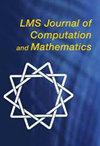非平稳纵向相关Com-Poisson数据中回归和离散参数估计的鲁棒算法
Q1 Mathematics
引用次数: 10
摘要
近年来,康-泊松模型由于其处理不同类型色散的灵活性而成为计数数据分析中最流行的离散模型之一。然而,在协变量与时间无关的平稳纵向com -泊松计数数据设置中,基于广义拟似然(GQL)方法的回归和分散参数估计涉及一些主要的计算困难,特别是在联合协方差矩阵的反演中。另一方面,在实际的纵向研究中,导致非平稳响应的时间相关协变量更常见。这意味着在非平稳设置下估计参数时将出现进一步的计算问题。本文通过一种多维共轭梯度法逼近GQL方法中病态协方差矩阵的逆,克服了这一问题。然后通过模拟AR(1)平稳和AR(1)非平稳纵向como - poisson计数以及实际癫痫发作计数来评估这种新型GQL方法的性能。然而,目前还没有一种算法来产生非平稳的纵向com -泊松计数,也没有一种GQL算法来估计非平稳设置下的参数。因此,本文还提供了一个框架来生成非平稳AR(1) com -泊松计数以及非平稳设置下GQL方程的构造。本文章由计算机程序翻译,如有差异,请以英文原文为准。
A robust algorithm for estimating regression and dispersion parameters in non-stationary longitudinally correlated Com–Poisson data
In recent years, Com–Poisson has emerged as one of the most popular discrete models in the analysis of count data owing to its flexibility in handling different types of dispersion. However, in a stationary longitudinal Com–Poisson count data set-up where the covariates are time independent, estimation of regression and dispersion parameters based on a generalized quasi-likelihood (GQL) approach involves some major computational difficulties particularly in the inversion of the joint covariance matrix. On the other hand, in practical real-life longitudinal studies, time-dependent covariates leading to non-stationary responses are more frequently encountered. This implies that further computational problems will now arise when estimating parameters under non-stationary set-ups. This paper overcomes this problem by approximating the inverse of the ill-conditioned covariance matrix in the GQL approach through a multidimensional conjugate gradient method. The performance of this novel version of the GQL approach is then assessed on simulations of AR(1) stationary and AR(1) non-stationary longitudinal Com–Poisson counts and on real-life epileptic seizure counts. However, there is not yet an algorithm to generate non-stationary longitudinal Com–Poisson counts nor a GQL algorithm to estimate the parameters under non-stationary set-ups. Thus, the paper also provides a framework to generate non-stationary AR(1) Com–Poisson counts along with the construction of a GQL equation under non-stationary set-ups.
求助全文
通过发布文献求助,成功后即可免费获取论文全文。
去求助
来源期刊

Lms Journal of Computation and Mathematics
MATHEMATICS, APPLIED-MATHEMATICS
CiteScore
2.60
自引率
0.00%
发文量
0
审稿时长
>12 weeks
期刊介绍:
LMS Journal of Computation and Mathematics has ceased publication. Its final volume is Volume 20 (2017). LMS Journal of Computation and Mathematics is an electronic-only resource that comprises papers on the computational aspects of mathematics, mathematical aspects of computation, and papers in mathematics which benefit from having been published electronically. The journal is refereed to the same high standard as the established LMS journals, and carries a commitment from the LMS to keep it archived into the indefinite future. Access is free until further notice.
 求助内容:
求助内容: 应助结果提醒方式:
应助结果提醒方式:


